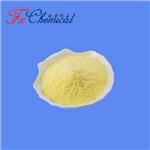- Germanium(II) iodide
-

- $0.00 / 1KG
-
2025-03-13
- CAS:13573-08-5
- Min. Order: 1KG
- Purity: 98%min
- Supply Ability: 30tons/month
|
| | Germanium(II) iodide Chemical Properties |
| Melting point | 460°C | | Boiling point | 545°C | | density | 5.37 g/mL at 25 °C(lit.) | | storage temp. | under inert gas (nitrogen or Argon) at 2–8 °C | | solubility | Soluble in dilute hydrochloric acid. | | form | orange-yellow hexagonal crystals | | Specific Gravity | 5.73 | | color | Yellow to brown | | Water Solubility | soluble H2O [CRC10] | | Sensitive | Air & Moisture Sensitive | | CAS DataBase Reference | 13573-08-5(CAS DataBase Reference) | | EPA Substance Registry System | Germanium iodide (GeI2) (13573-08-5) |
| Hazard Codes | C | | Risk Statements | 34 | | Safety Statements | 23-26-27-36/37/39-45 | | RIDADR | UN 3260 8/PG 2 | | WGK Germany | 3 | | F | 10-19-21 | | TSCA | Yes | | HazardClass | 8 | | PackingGroup | II | | HS Code | 2827600090 |
| | Germanium(II) iodide Usage And Synthesis |
| Description | Germanium diiodide (also named as germanium (II) iodide) is a yellow crystalline solid which decomposes on melting. Its specific density is 5.37. It can be sublimed at 240°C in a vacuum.1 It can be used to obtain high yield of germanium nanocrystals.2
| | References |
- https://en.wikipedia.org/wiki/Germanium_iodide
- X. Lu, B. A. Korgel, K. P. Johnston, High yield of germanium nanocrystals synthesized from germanium diiodide in solution, Chemistry of Materials, 2005, vol. 17, pp. 6479-6485
| | Chemical Properties | Germanium(II) iodide is a yellow to gold flake or powder. It can dissolve in cold water, concentrated hydriodic acid, and dilute acid. It has limited solubility in chloroform and carbon tetrachloride, while it does not dissolve in carbon disulfide. It decomposes in hot water and reacts with an ammonia solution to form imine germanium. Under vacuum, it sublimates at 240°C. It remains stable in dry air but undergoes hydrolysis in moist air. | | Uses | Germanium(II) iodide acts as a reagent that forms stable ionic adducts with carbenes. It is also used in the preparation of allylgermanes by reacting with allylstannanes. Further, it reacts with allyl bromide in the presence of zinc iodide to get allylgermanium(IV), which on reacts with carbonyl compounds to give the corresponding homoallylic alcohols. | | Preparation | From a germanium sulfide powder by adding excess 57% concentrated hydriodic acid, under stirring at 100 ℃ for the reaction, filtered while hot, the filtrate is slowly cooled system. It can also be made by adding germanium tetraiodide to distilled water and 57% concentrated hydriodic acid with stirring, adding 50% hypophosphite, boiling under reflux, crystallizing after reaction, washing with dilute hydriodic acid and drying. | | reaction suitability | reagent type: catalyst
core: germanium |
| | Germanium(II) iodide Preparation Products And Raw materials |
|